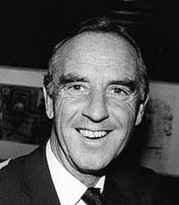John Cain II
|
|
John Cain (born 26 April 1931), Australian politician, was Labor Premier of the state of Victoria from 1982 to 1990.
Cain was born in Melbourne, the son of John Cain, leader of the Labor Party in Victoria from 1937 to 1957 and three times Premier. He was educated at state and private schools and at the University of Melbourne, where he graduated in law. He practised law in suburban Melbourne, and was Chairman of the Victorian Law Institute in 1971-1972. He was also a member of the Law Council of Australia and a member of the Australian Law Reform Commission.
Cain was 26 at the time of the 1955 split in the Labor Party that brought down his father's last government. Although a member of the party since his youth, he stayed out of politics until relatively late. He was a supporter of the group led by Bob Hawke and others that in 1971 took over the Victorian Labor Party from the left-wingers who had run it for many years. He became Vice-Chairman of the Victorian Labor Party in 1973, and in 1976 he was elected to the Victorian Legislative Assembly as MP for Bundoora.
By 1976 Labor had been in opposition for 21 years, and Cain became determined to lead the party back into government. He became shadow Attorney-General under the leadership of Frank Wilkes, but when Wilkes lost the 1979 election to the Liberal premier, Dick Hamer, Cain challenged him for the leadership, becoming leader in September 1981. In March 1982 Cain defeated the Liberals and formed the first Labor government in Victoria for 27 years.
During the first six years of his Premiership, Cain remained very popular with the Victorian electorate, and was easily elected to a second term in 1985. His government carried out many reforms to Victorian government, particularly in the areas of education, environment, law reform and public administration. Cain was a Keynesian economist, opposed to the doctrines of economic rationalism, and he increased government spending in the hope of stimulating growth and investment, particularly through the Victorian Economic Development Corporation. This worked so long as the national economy remained buoyant.
Cain was also responsible for the appointment as Governor of Davis McCaughey, then aged 71, who served from 1986 to 1992. A highly respected theologian, McCaughey restored the standing of the office of Governor after the resignation of Rear Admiral Sir Brian Murray following accusations that he had improperly accepted free air travel.
During its second term Cain's government began to run into difficulties with the state budget. The stock market crash of 1987 created a crisis which forced the government to cut spending, alienating its trade union supporters. The deregulation of the financial system by the Hawke federal Labor government encouraged the banks and building societies to lend money freely, creating the potential for a financial crisis. The State Bank of Victoria, in particular its merchant banking arm Tricontinental, ran up a huge portfolion of bad loans, without adequate government supervision.
The Cain government was narrowly re-elected to a third term in 1988, but immediately after the election a huge shortfall in the government's workers' compensation scheme, WorkCare, was revealed. This was followed by a budgetary crisis that the government was unable to deal with, partly because of the unwillingness of the unions and the factions within the Labor Party to allow Cain to respond flexibly to the situation. The problems were made worse by Cain's poor relations with Hawke and his Treasurer, Paul Keating, who blamed the crisis on Cain's overspending and refused to bail Victoria out of its difficulties.
In February 1990 it was rumoured that a private building society, Pyramid, was in difficulties. Although the society was not under government control, ministers reassured investors that it was sound. When it failed, causing thousands of investors to lose their money, the government was blamed. This was followed shortly after by the collapse of Tricontinental, which threatened to bankrupt the State Bank, Victoria's largest financial institutions. The bank eventually had to be sold to the Commonwealth Bank, which was shortly after privatised by the federal government. These disasters permanently ruined Cain's reputation for financial management.
By this time Cain was becoming frustrated and bitter at the refusal of his party and the unions to allow his government to cut government spending to bring the budget under control. He issued an ultimatum at the Labor Party Conference to "back me or sack me." When the undermining of his position continued, he resigned in August 1990. He retired from Parliament in 1992, at the election at which his successor, Joan Kirner, led Labor to a massive defeat.
Cain became a Professorial Fellow in politics at the University of Melbourne in 1991, and has since completed three books. In 2004 he surfaced in the media with a damning critique of the University of Melbourne's experimentation with risky financial ventures and its departure from its public mission. Off Course: From Public Place to Marketplace at Melbourne University attracted a range of critical commentary. He is a regular political commentator on local radio.
Books
- Cain, J. 1995. John Cain's years - power, parties and politics. Melbourne University Publishing.
- Cain, J. 1998. On With the Show. Melbourne: Prowling Tiger Press. (on the entertainment industry in Australia)
- Cain J and J Hewitt. 2004. Off Course: From Public Place to Marketplace at Melbourne University (http://www.scribepub.com.au/Catalogue/OffCourse.html). Melbourne: Scribe.
| Preceded by: Lindsay Thompson | Premier of Victoria 1982-1990 | Succeeded by: Joan Kirner |

